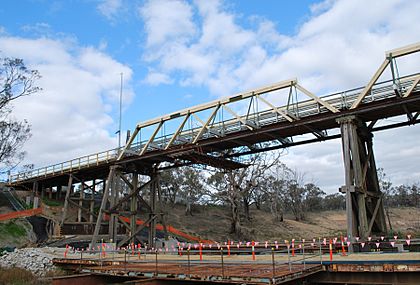Coonamit Bridge over Wakool River facts for kids
Quick facts for kids Coonamit Bridge |
|
|---|---|

Coonamit Bridge over Wakool River in 2010
|
|
| Coordinates | 35°08′07″S 143°40′53″E / 35.1354°S 143.6814°E |
| Carries | Swan Hill Road |
| Crosses | Wakool River |
| Locale | Murray River Council, Riverina, New South Wales, Australia |
| Owner | Roads and Maritime Services |
| Characteristics | |
| Design | Dare truss |
| Material | Timber |
| Total length | 128 metres (420 ft) |
| Width | 5.5 metres (18 ft) |
| Longest span | 28.2 metres (93 ft) |
| Number of spans | Two |
| History | |
| Architect | Harvey Dare |
| Opened | 1929 |
| Official name: Coonamit Bridge over Wakool River | |
| Type: | State heritage (built) |
| Designated: | 20 June 2000 |
| Reference #: | 1464 |
| Type: | Road Bridge |
| Category: | Transport - Land |
The Coonamit Bridge is a special road bridge in New South Wales, Australia. It's considered a heritage-listed site, which means it's an important part of history and needs to be protected. This bridge carries Swan Hill Road over the Wakool River, connecting two places called Mallan and Dilpurra. It was designed by an engineer named Harvey Dare and finished in 1929. The bridge is owned by Roads and Maritime Services, a government group in New South Wales. It was added to the New South Wales State Heritage Register on June 20, 2000.
Contents
A Look Back: The Story of the Bridge
Imagine a time when crossing rivers was really hard, especially when it rained! Before bridges like Coonamit were built, moving goods like farm produce was very expensive. Only valuable items like wool could be transported easily.
Why Timber Bridges Were Popular
The Public Works Department liked using timber for bridges from the mid-1800s to the early 1900s. Why? Because timber was cheap and could be found locally. The government wanted to build many roads and bridges without spending too much money. Using local timber meant they didn't have to import expensive iron or steel from England.
Harvey Dare: The Bridge Designer
Harvey Dare was a very important engineer in the Public Works Department. He designed the "Dare truss" and other bridges. He played a big role in building infrastructure in New South Wales in the early 1900s.
New South Wales: The "Timber Bridge State"
Timber bridges were so common in New South Wales that travelers used to call it the "timber bridge state." This shows how important these bridges were for connecting different parts of the region.
What the Coonamit Bridge Looks Like
The Coonamit Bridge is a "Dare type" timber truss road bridge. It has two main sections, called spans, each about 28.2 metres (93 ft) long. There are also smaller sections leading up to the main part.
How Long and Wide Is It?
The bridge has five approach spans on one side and two on the other. This makes the total length of the bridge about 128 metres (420 ft). The road part, called the carriage way, is at least 5.5 metres (18 ft) wide. The whole bridge is supported by strong timber posts. It also has a timber fence, or guard rail, along its entire length for safety.
How Is It Doing Today?
In 2018, the Coonamit Bridge was in good physical condition. It is still strong and well-preserved.
Why the Coonamit Bridge Is Special
The Coonamit Bridge is a "Dare type" timber truss bridge that was finished in 1929. It's important for many reasons, connecting us to key historical events and people.
Connecting to History
- Road Network Growth: This bridge shows how the road network in New South Wales grew over time, helping people and goods move around more easily.
- New Ideas: It also shows how people in NSW started to accept American design ideas for bridges.
- Harvey Dare's Legacy: The bridge is linked to Harvey Dare, the engineer who designed this specific type of truss.
The Dare Truss Design
The "Dare truss" was the fifth and final major design improvement for timber truss bridges in NSW. It was similar to an earlier design called the "Allan truss," but it was stronger and easier to keep in good shape. This improved design was a big step forward in bridge engineering.
A Rare Survivor
In 1998, there were only 27 "Dare truss" bridges left in New South Wales out of 40 that were built. Overall, only 82 timber truss road bridges survived out of more than 400! The Coonamit Bridge is also special because it was the very last timber truss bridge ever built in New South Wales. This makes it quite rare and historically significant.
State Heritage Listing
The Coonamit Bridge over Wakool River was officially added to the New South Wales State Heritage Register on June 20, 2000. This means it's recognized as a very important historical site for the entire state. It's valued for its technical design and its place in history.

